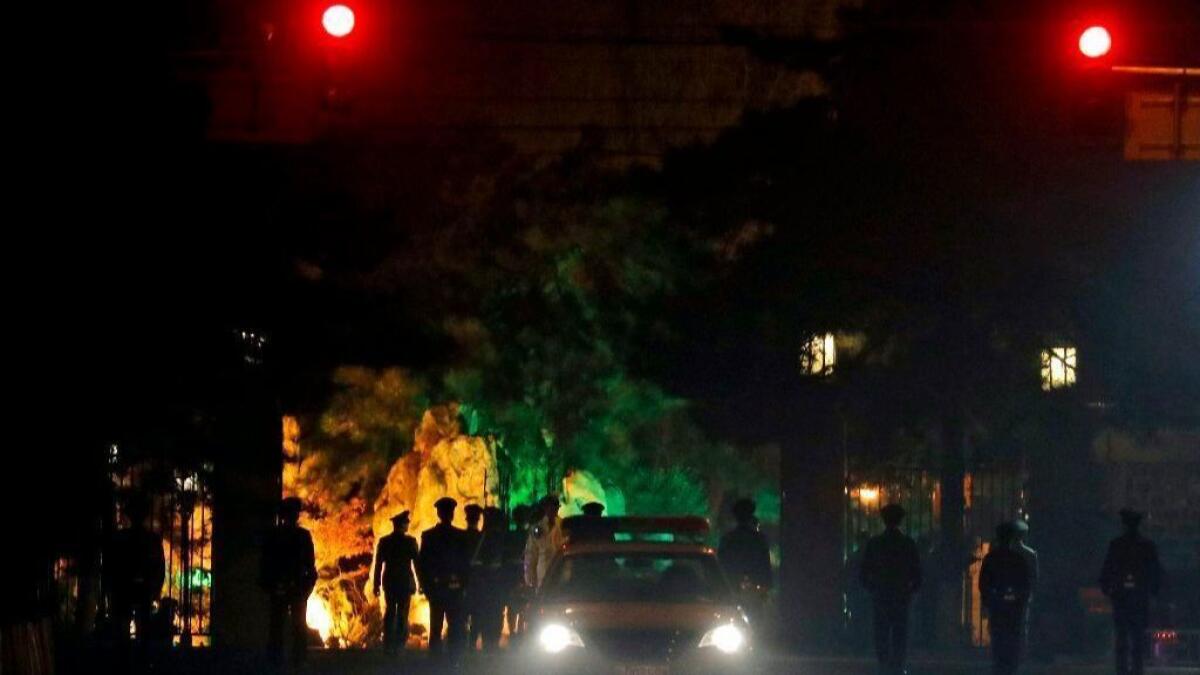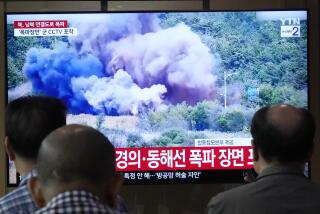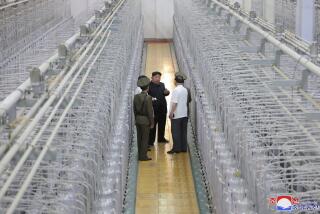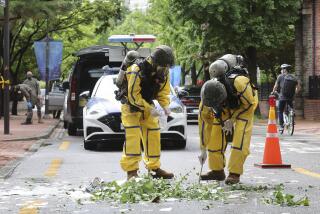Speculation blazes in Beijing: Is North Korea’s reclusive leader Kim Jong Un in town?

Reporting from BEIJING — An armored mystery train. A flurry of activity at a Beijing guesthouse where senior North Korean officials have been known to stay. Tourists barred from Tiananmen Square.
The strangeness in the Chinese capital on Monday suggested that something big was happening, and the speculation was that North Korean leader Kim Jong Un was visiting for consultations ahead of a pair of crucial summits — including a possible meeting in May with President Trump.
There was no official word from Chinese or South Korean officials — or from North Korea, which in years past routinely announced visits to Beijing by Kim’s late father, Kim Jong Il, only after he had come and gone.
News media in Japan, which keeps a close eye on its nuclear-armed neighbor, first took note of an armored train crossing from North Korea at the Chinese border city of Dandong. Japanese broadcaster Nippon television on Monday evening showed images of the 21-car train, with green carriages bearing a distinctive yellow stripe. And the Bloomberg news agency cited unidentified sources as saying the North Korean leader was in Beijing.
Signs swiftly materialized on the ground that a high-level visit was afoot. A large motorcade was seen entering the Diaoyutai State Guesthouse, greeted by an honor guard, the Associated Press reported. The Reuters news agency said Beijing’s Tiananmen Square was emptied of tourists, the usual prelude to a state meeting taking place in the Great Hall of the People.
Social media in Japan, South Korea and China lit up with reports of other portents: extensive train delays in and near Beijing, screens blocking the view of the station in Dandong, and stepped-up security starting Monday afternoon on a major Beijing thoroughfare.
If the reports are true, it would be Kim’s first known foray outside North Korea since he took power upon his father’s death in 2011. And it would signal that the leadership in China, North Korea’s most important patron, wanted to have a face-to-face encounter with the untested and impetuous young leader before he sits down with South Korea’s president in April, and possibly with Trump the following month.
Kim has not been seen in public since March 5, when he met with a South Korean delegation. The South Korean newspaper Chosun Ilbo reported on “speculation that he is hard at work preparing for scheduled summits with South Korea and the U.S.”
White House Deputy Press Secretary Raj Shah said Monday that he could not confirm the reports.
In South Korea, government officials said the same.
“The government is closely monitoring the situation and movements while communicating closely with related countries,” said Nam Sang-kyu, a spokesman for President Moon Jae-in.
North Korea’s official Korean Central News Agency did not announce a trip to Beijing. Its top stories on Monday included a commentary accusing Japan of “impudence and moral baseness” for its criticism of Pyongyang’s nuclear and missile programs, and news of an official inspection of an industrial area.
The North’s invitation to Trump was relayed this month by South Korean officials. Pyongyang has not confirmed that the talks will take place, and no date or venue has been set.
The U.S. president caught his own advisors by surprise by announcing he was prepared to meet Kim. The unexpected move drew praise from Trump’s backers, who said it showed his bellicose style — including mocking Kim as “Little Rocket Man” and warning of “fire and fury” if the North took its provocations too far — had paid dividends.
Critics of the president, though, said agreeing to the meeting signaled naivete, bestowing enormous prestige on Kim without any concessions having been made in advance by Pyongyang. The Trump administration swiftly clarified that the aim was denuclearization of the Korean peninsula.
Japan’s Kyodo news agency, without confirming that the mystery visitor was Kim, said high-level talks in the Chinese capital were meant to shore up ties between Beijing and Pyongyang.
The Trump administration has reportedly sought help from China in reining in Kim, with little real success. China is by far North Korea’s most significant link to the outside world, and it has been highly critical of unilateral U.S. sanctions targeting the North that go beyond those approved late last year by the United Nations Security Council.
China watchers like author and blogger Gordon G. Chang said if Kim was indeed in Beijing, “all this talk of China losing influence in Pyongyang is incorrect analysis.”
“China has great influence, and it gets what it wants when it pulls the string,” he tweeted. “It looks as if it just pulled the string.”
Both of Kim’s predecessors — his grandfather Kim Il Sung, who ruled the country from its founding in 1948 until his death in 1994, and his father, Kim Jong Il, who ruled from 1994 until his death in 2011 — preferred to travel abroad on heavily armored luxury trains.
In 1984, Kim Il Sung traveled by train through China and the Soviet Union to several countries in Eastern Europe. In 2011, Kim Jong Il took a train to Ulan-Ude, Russia, to meet with Dmitry Medvedev, the Russian president at the time.
Kim Jong Il reportedly preferred train travel as he was afraid to fly. He kept six trains, equipped with conference rooms and reception halls, the Chosun Ilbo reported in 2009. His personal train would travel between two other trains — one that ran ahead as a safety check, and another that carried staff and security.
King reported from Washington and Kaiman reported from Beijing. Special correspondent Matt Stiles in Seoul contributed to this report.
UPDATES:
8 p.m.: This article was updated with background as well as statements from the White House and the South Korean government.
This article was originally published at 1:15 p.m.
More to Read
Sign up for Essential California
The most important California stories and recommendations in your inbox every morning.
You may occasionally receive promotional content from the Los Angeles Times.










